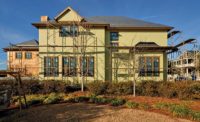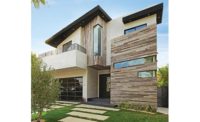In the mid-1980s, if an individual was driving around a new, mid-priced residential development in the suburban areas of Atlanta, Nashville, Philadelphia, Chicago, or any major city in the country, that individual would notice that at least half of the houses being built were using EIFS. It may surprise you to know that at one point in time, 30 percent of the EIFS business was in the residential market. Currently, the EIFS business in this market segment is less than 5 percent.
Residential EIFS Gains Traction
As post World War II Germany began the rebuilding process, new building techniques began to emerge in the construction market. One of these new concepts was EIFS. It gained popularity due to its ability to reclad buildings while providing energy efficiency. The concept gained popularity throughout Germany. Then in 1969, Frank Morsilli founded Dryvit Systems Inc. and introduced this German building concept in the United States.
Dryvit found ways to introduce this new concept in the U.S. market. It began like most start-up industries do: they tried to sell the EIFS building approach to anyone who would listen to their sales spiel? A few jobs were sold to renovate store fronts or small office buildings, then a few houses were reclad with this new system. The main sales pitch was that the systems were energy efficient which made sense in Germany where energy costs were three to four times higher than in the United States. But as one could imagine, that plan didn’t work in the States because the cost of energy was so inexpensive.
Sales calls were mostly made on architects and builders but with nominal success. Sales efforts then began moving toward the plasterers. After all, the plasterers were the EIFS trade in Germany but not the U.S. The American tradesmen began to see EIFS as a lighter, easier material to work with than cement plaster or stucco. Jobs could also be done quicker so plasterers began to convert cement stucco jobs to EIFS. Once the sales effort began to concentrate more on the plasterers, then business began to grow. By the mid-70s, EIFS sales were beginning to show consistent growth. The majority of the jobs were small to midsize commercial projects with a few houses done here and there.
EIFS Housing Boom Begins
Houses with EIFS were an afterthought until one day in Atlanta when that all changed. Billy Joe Donaldson, a local plasterer, convinced one of his builders to let him use EIFS instead of stucco on a house they were constructing in a new development. The development featured mid-priced mostly brick houses scattered with a few stucco homes. Donaldson had worked with EIFS on several commercial jobs and thought it would be great on a house. The builder agreed to give EIFS a try and as soon as the house was ready for the cladding, Donaldson’s team went into action. The builder was amazed at the finished home.
Curb Appeal
The walls of the two-story house featured a light beige, sand-textured finish and the corners of the front elevation were decorated from top to bottom with bright white quoins. The design carried on to the windows and doors which were outlined with white trim features. This was all accomplished using EPS (expanded polystyrene) to carve out these unique shapes. The application quality was exceptional, it was completed ahead of schedule, and at the same cost as stucco. Before the landscaping was completed, the house was sold. It was the shapes and the detail work that appealed to the buyer. The brick houses in the development didn’t stand a chance against the curb appeal of the EIFS house.
As the scaffolding was disassembled on the first EIFS house, the builder had another house for Donaldson to do. Soon another home was added and, before you knew it, he had all the work he could handle just installing EIFS on houses. Most people familiar with EIFS in the early days give Donaldson the credit for taking EIFS into the residential market. The work was always of high quality and done on time. His craftsmanship with the foam shapes was most appealing. EIFS was tailored to create a niche in the residential market.
As the business evolved, Donaldson devised methods to increase the production. He established a team approach. Production teams were set up for each phase of the EIFS application process. He had a scaffolding crew, and a foam crew, whose job it was to cut EPS shapes and attach the foam. Wrapping walls and applying the basecoat and mesh was completed by another crew. Then the last crew’s job was to apply the finish and the sealants. Maintaining the workmanship and quality were keys to the success as the builder had confidence in these new systems due to the quality commitment by the applicator.
Impress then Demand
It took one builder to get on board with the first EIFS house then the demand exploded. As builders and home buyers discovered the design options that EIFS offered, EIFS houses spread throughout Atlanta. Then the concept spread to other markets in the southern states and on up into the Midwest. As the ’70s
ended and the ’80s began, a large number of EIFS houses could be found in almost every major city in the country.
In the late seventies it was not uncommon to drive into a new mid-priced subdivision and see 50 percent of the houses clad with EIFS. Even in the higher priced residential developments, EIFS controlled a large share of the market. The higher-end houses utilized an amazing amount of foam shapes as it was used to decorate columns, chimneys, decks, balconies, etc. It was energy efficiency that got EIFS introduced into the United States market but it was shapes, color, and the unlimited design options that put EIFS on the residential map.
EIFS had become the cladding of choice in the residential market mainly due to its curb appeal. The future looked bright. EIFS had found a real niche in the market.







